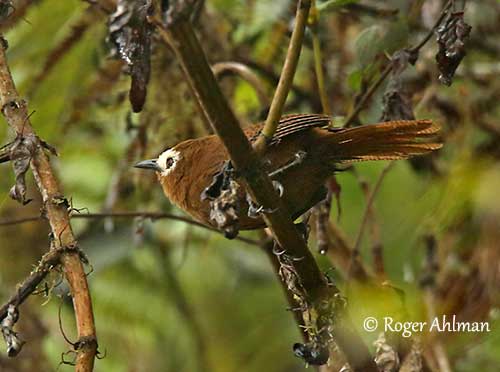
The juvenile resembles adult but the white areas are absent from the head. It may have a broad pale grey superciliary and pale bill.
RANGE:
The Peruvian Wren is found on the eastern slope of the Andes of Peru, from Amazonas S to Ayacucho.
HABITAT:
The Peruvian Wren frequents the undergrowth of humid montane forest, forest edges and adjacent secondary growths, between 1,500 and 3,200 metres of elevation.
CALLS AND SONGS: SOUNDS BY XENO-CANTO
The Peruvian Wren gives a fast, dry chattering “ch-d-d-t” also used as alarm call.
The beautiful song is a medley of musical series of clear whistles, trills and warbling notes.
Both song and calls are often given in chorus by several group members.
BEHAVIOUR IN THE WILD:
The Peruvian Wren probably feeds on small invertebrates caught on or near the ground while foraging in the dense vegetation.
It is gregarious and often seen in groups of 12 or more individuals, including other bird species. The group usually includes a pair, immatures and juveniles. The subadults are suspected to be helpers at the nest during the breeding season.
But if the members of the genus Campylorhynchus are known to perform co-operative breeding, nothing is known about the present species and more information is required.
From an observation of one nest, the structure is purse-shaped and suspended from a bamboo stem.
The Peruvian Wren is probably sedentary.
It only performs short-distance flights within the vegetation.
REPRODUCTION OF THIS SPECIES:
The breeding season is not well known. Fledglings were observed in August, and juveniles in February, June and November, involving a protracted breeding season.
One nest was found in late September in Huánuco. It was a purse-shaped structure suspended from curving bamboo stem. The nest was made with rootlets interwoven with green moss. The entrance of the pouch was a downturned tunnel with a circular hole encircled by green moss. The upper part of this structure was made with dry bamboo leaves.
On that date, the nests contained one recently hatched chick and one pale cream egg with sparse red markings.
There is no information regarding both incubation and fledgling periods.
PROTECTION / THREATS / STATUS:
The Peruvian Wren is described as common throughout the breeding range, but the population is suspected to be declining due to fragmentation and destruction of the habitat.
But the species is not considered globally threatened and the Peruvian Wren is currently evaluated as Least Concern.
Fr: Troglodyte brun
Ang: Peruvian Wren
All: Sepiazaunkönig
Esp: Cucarachero Peruano
Ita: Scricciolo del Perù
Nd: Sepiabruine Winterkoning
Sd: perugärdsmyg
Photographer:
Roger Ahlman
Pbase Galleries Peru and Ecuador
Text by Nicole Bouglouan
Sources:
HANDBOOK OF THE BIRDS OF THE WORLD Vol 10 by Josep del Hoyo-Andrew Elliott-David Christie - Lynx Edicions - ISBN: 8487334725
BIRDS OF SOUTH AMERICA – Passerines - by Robert S. Ridgely and Guy Tudor – HELM Field Guides – ISBN: 9781408113424
WRENS, DIPPERS AND THRASHERS by Brewer David – illustrated by Barry Kent Mackay- Yale University Press - ISBN: 0300090595
BIRDS OF PERU by Thomas S. Schulenberg, Douglas F. Stotz, Daniel F. Lane, John P. O’Neill, Theodore A. Parker III – Princeton University Press 2007– ISBN: 978-0-691-13023-1
Neotropical Birds – Cornell Lab of Ornithology
Planetbirds - A blog dedicated to the thousands of bird species that fly, swim or walk on our planet
Peruvian Wren
Cinnycerthia peruana
Passeriformes Order – Troglodytidae Family
INTRODUCTION:
The Peruvian Wren is one of the four members of the genus Cinnycerthia. It is endemic to Peruvian Andes where it occurs in humid montane forest on the E slope of the Andes, between 1,500 and 3,200 metres of elevation.
It is very gregarious and often seen in groups. It feeds on small invertebrates caught on or near the ground. It nests in a purse-shaped structure hanging from a branch.
The Peruvian Wren is described as fairly common, but habitat fragmentation and destruction may affect this species, although it is not globally threatened for the moment.
DESCRIPTION OF THE BIRD:
Biometrics:
Length: 15-16 cm
Weight: 19,5-20 g
The Peruvian Wren has uniform chestnut-brown plumage, especially on crown and rump, whereas nape and back are less rufescent. On the upperwing, coverts, primary and secondary flight-feathers are rich chestnut with distinct, narrow black barring. The tail is chestnut-brown with fine blackish bars.
On the underparts, chin and throat are orange-brown, whereas breast, belly and flanks are duller and darker.
The Peruvian Wren may show three head patterns within the species. Some birds have entirely chestnut-brown head, while others show a variable amount of white. They may have a broad, white area around the eyes, but other birds may show more extensive amount of white, including on the forehead or more.
The thin bill is dark brown to blackish with yellow gape. The eyes are chestnut-brown. Legs and feet are dark grey to blackish.
Male and female are similar.
